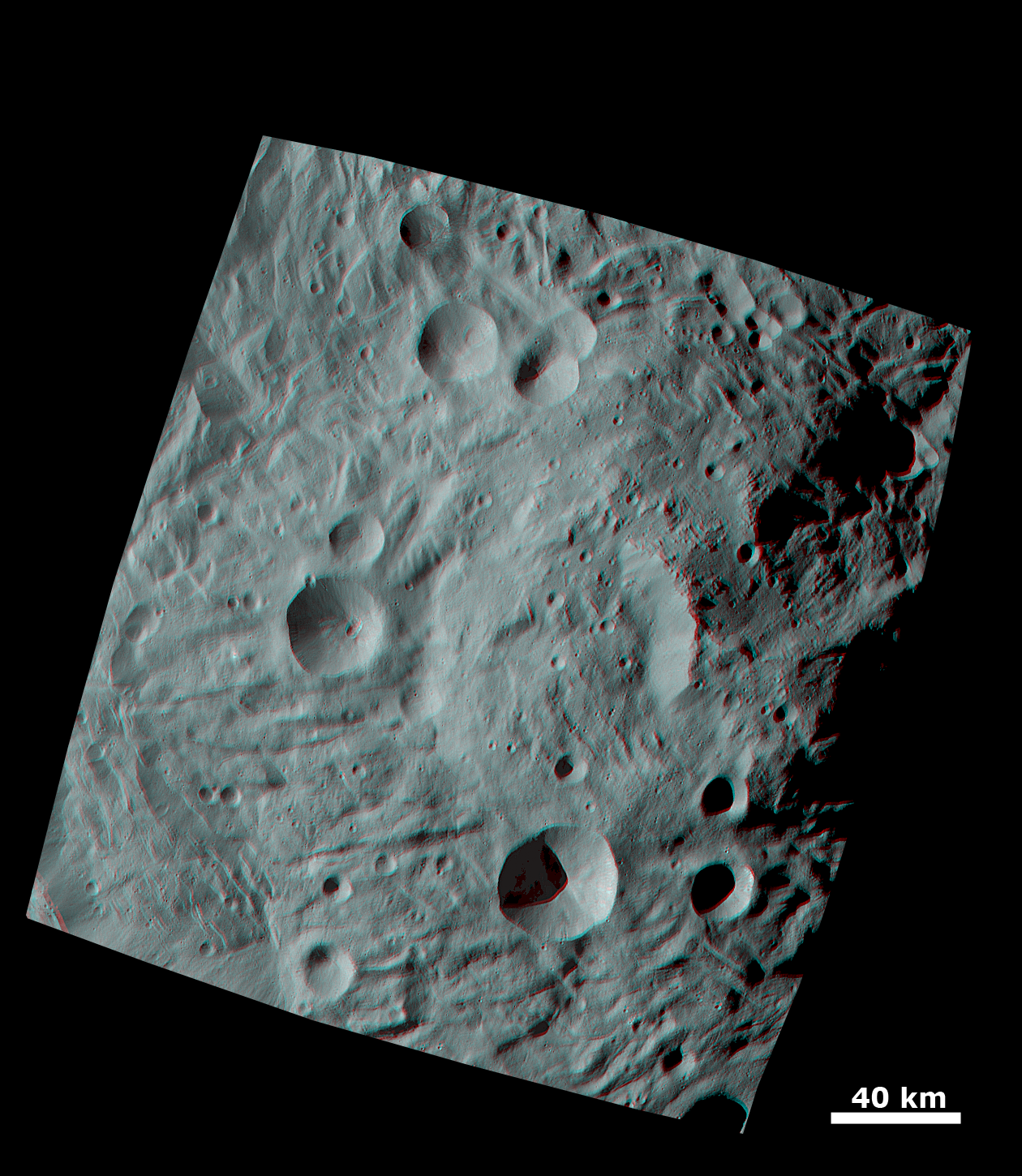By Jennifer Scully

The above image was generated from Dawn topographic data and is a tilted view of Vesta’s Rheasilvia impact basin, which is a ~500km depression that dominates the topography of Vesta’s southern hemisphere.
The Dawn spacecraft arrived at the asteroid Vesta on 16th July 2011, with the aim to understand the evolution of Vesta. Since then it has been acquiring data with its three different instruments: the Framing Camera (FC), the Visible and Infrared Spectrometer (VIR) and the Gamma Ray and Neutron Detector (GRaND).
Even before Dawn reached Vesta the Rheasilvia basin was visible in Hubble images of the asteroid (for more information see Thomas, P.C. et al. 1997. Science, 277, 1492-1495). The Rheasilvia basin contains a large central complex, which is visible as the roughly circular mound offset from the center in the anaglyph image below. To create this anaglyph, two differently colored images were superimposed with an offset to create depth. When viewed through red-blue glasses it shows a 3D view of Vesta’s surface.

The Rheasilvia central complex is approximately 200km in diameter and has approximately 20km of relief from its base, which makes it about 2.5 taller than Mt. Everest! The topographic differences in the Rheasilvia basin are clear in the cross section in the figure below, which shows the central complex in the foreground and the rim in the background. Also evident is that the rim of the Rheasilvia basin is very pronounced in places. A part of the rim forms a steep cliff, called a scarp, visible in the right side of the figure. There is also a large scarp on the central complex and surrounding the central complex is the hummocky (i.e. wavy/undulating) texture of the Rheasilvia basin. Possible formation mechanisms for this hummocky texture are currently under investigation.

The Rheasilvia basin, and the impact that formed it, is possibly the source of the Vestoid meteorites. The Vestoids are a suit of meteorites believed to come from Vesta because their reflectance spectra match the average reflectance spectrum of Vesta (for more information see McSween, H.Y. et al. 2010. Space Science Reviews, 163, 141-174). For this reason the Dawn mission is unusual because samples of the asteroid were already on Earth before the Dawn spacecraft, or any spacecraft, reached and orbited Vesta. These meteorite samples, combined with the remotely sensed data from Dawn, will help to develop a picture of the origin and evolution of Vesta. It is thought that Vesta formed within the first few million years of the solar system and, unlike the Earth, Vesta has not been subsequently modified by geological and atmospheric processes. Thus, developing a picture of the origin and evolution of Vesta provides a window into the development of the early solar system.
When Dawn leaves Vesta in late 2012 it will travel to the asteroid Ceres. Ceres is the largest asteroid in the asteroid belt and, unlike Vesta, likely contains water ice. Consequently, Vesta and Ceres, which are the most massive asteroids in the solar system, provide insights into the evolution of both the rocky bodies and the icier bodies of the solar system. For more information about the Dawn mission see the paper “The Dawn Mission to Vesta and Ceres” available at http://www.springerlink.com/content/f46t37l0617571j6/. For more images from the Dawn mission see the Dawn Image of the Day website at http://dawn.jpl.nasa.gov/multimedia/imageoftheday.
The Dawn mission to Vesta and Ceres is managed by NASA’s Jet Propulsion Laboratory, a division of the California Institute of Technology in Pasadena, for NASA’s Science Mission Directorate, Washington D.C. UCLA is responsible for overall Dawn mission science. The Dawn framing cameras have been developed and built under the leadership of the Max Planck Institute for Solar System Research, Katlenburg-Lindau, Germany, with significant contributions by DLR German Aerospace Center, Institute of Planetary Research, Berlin, and in coordination with the Institute of Computer and Communication Network Engineering, Braunschweig. The Framing Camera project is funded by the Max Planck Society, DLR, and NASA/JPL.
Follow Iplex